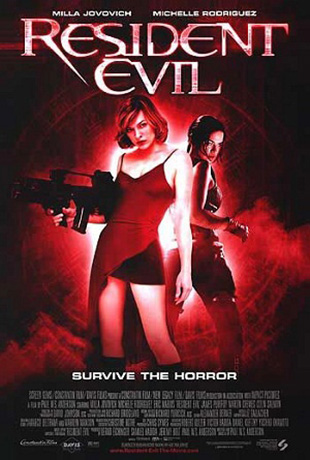
Resident Evil
How to Make a
Successful Film Series
Out of a Video Game
Bonus Interview with the late, lamented
Ray Zone (1947-2012)
by Jessie Lilley
[This article first appeared in truncated form in Famous Monster of Filmland Issue # 251. The article in its entirety, is presented here with permission from the publisher.]
The last thing I ever wanted to do was get involved in what I assumed was another hash up of the Apocalypse on film; even worse, the idea of the film was purportedly based on a video game. I was not looking forward to the three DVDs that had been glaring at me from the top of the TV for a full week. Finding myself with some free time early one morning however, I admitted defeat and sat myself down-fortified with some strong coffee, to view the films. Imagine my astonishment when about 10 minutes into the first film I realized I was enjoying myself. Either I’m getting less picky in my dotage or this film is actually pretty good.
A little history: RESIDENT EVIL is based on the Capcom PlayStation game of the same name (it’s called Biohazard in Japan which is where the game originated). We won’t dwell on the game itself, other than to note the basic premise: learn the mystery of the mansion—while vanquishing zombies, their zombified dogs and countless other bad guys along the way—and escape alive. In short, the game is your basic quest fantasy.
RESIDENT EVIL finds our heroin, Alice, in The Mansion, not knowing who she is. She is rounded up, along with Matt the Cop and brought to the Hive, via a fancy and high speed subway. There, Alice and Matt meet up with some other characters (Spence, Rain, Kaplan and J.D.) who quickly band together to be the good guys. As her memory returns, Alice becomes aware of the fact that while she’s an Umbrella employee, she is also out to blow the lid off the place by helping to smuggle a T-Virus sample out of that corporation’s underground lair.
It should be noted that there are elements of Lewis Carroll’s ALICE’S ADVENTURES IN WONDERLAND all though this film. While the video game’s main character is named Jill, Milla Jovovich’s character is Alice; but that’s only the first reference. You’ll notice the entrance to the underground railway is a mirrored door, thus forcing our little band to step through the looking glass (if you will) and enter the realm of the Red Queen; the Hive’s answer to 2001: A SPACE ODYSSEY’s HAL 9000. I don’t believe it’s any accident that the Red Queen’s first kill is a beheading. And, of course, there in the Hive itself—much of the testing done regarding the T-Virus is done on white rabbits.
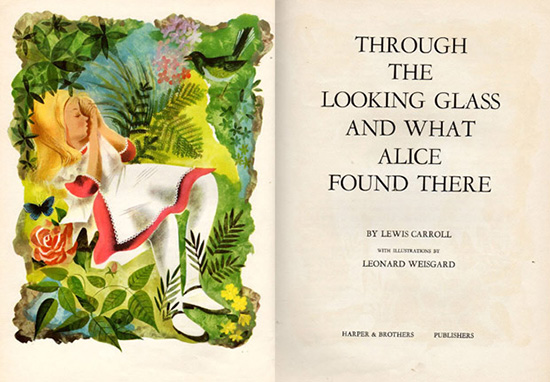 Sir John Tenniel, Illustrator (1820 – 1914)
Based on the many aspects of Alice in RE, we can pull up THROUGH THE LOOKING GLASS AND WHAT ALICE FOUND THERE as well, wherein Alice views several versions of herself in said glass, albeit only briefly; we can draw another parallel with the introduction of the White Queen. However, when we consider Carroll’s Alice as the child that she is, with no power over the laws of the adult world, not to mention no leveling characters in RE as there are in Wonderland, i.e., the Cheshire Cat or the Caterpillar, the parallels fall apart. RE’s Alice is no child and while she has little control over the powers that be, she makes a fine stand in taking control of her own destiny within her world. Carroll’s Alice never had that chance. One way or another though, there’s definitely a Lewis Carroll fan in the wood pile.
The first film moves along with zombies popping up at the worst moments, a super baddie referred to as the Licker, relentlessly pursues our heroes (who are dropping like flies, by the way—not to mention the wayside), but eventually, Alice and Matt escape the Hive and make it back to The Mansion. They are once more thwarted; this time by a collection of insistent scientists, intent on dragging them right back to where they came from. This is, of course, the perfect time for Matt to begin the mutation process, cheering the scientists who declare that he will be put into the Nemesis Project. Alice kicks and claws and gets nowhere but sedated and strapped to a hospital gurney. When she wakes, she finds she is able to extract herself and leaves the hospital, only to step into a world peopled by T-Virus mutants and those who are trying to escape them. We are given a bird’s eye view of the chaos in the streets and the credits roll.
RESIDENT EVIL: APOCALYPSE opens hours after the initial outbreak and Alice finds she now has superhero powers—a happy by-product of the experiments performed on her while sedated.
Something else that happened while she was under was that an elite team was sent into the Hive to eradicate the zombies and other such mutant life forms that had developed due to exposure to the T-Virus. Strangely enough, the elite team wound up being eradicated instead. The merry band of ghouls was then free to launch itself upon Raccoon City to spread mayhem and death wherever it roved. This was the world our girl stepped into after waking on the hospital gurney. Being the resourceful lass that she is, Alice locates a police car, grabs a shotgun and begins to wend her way through the streets to see what she can see.
The powers that be, in the person of one Major Timothy Cain, have closed off the city to the outside world and are having the panicked citizens go through a Checkpoint Charlie setup, but when it’s confirmed that the virus has reached the gates, all egress is closed and the hapless citizenry is told to go home. They must fend for themselves; with one exception.
Dr. Charles Ashford, an Umbrella big wig, wants his daughter. She was in school when the outbreak occurred and didn’t get through the gates.
Meanwhile: Carlos, Nicholai and Yuri—intrepid Umbrella soldiers—have teamed up with some units from the Special Tactics and Rescue Service (S.T.A.R.S.) to deal with a particularly nasty crowd of zombies. Being sadly outclassed in this bizarre street fight, they—including a bitten and therefore infected Yuri—and the remaining S.T.A.R.S operatives (Jill, Terri and Peyton) retreat to the confines of a local church. To their mutual annoyance, the place is inhabitied by several Lickers who gleefully go about attempting to nail this new and unexpected prey. Enter Super Alice who saves the day, gracefully stepping into the role of leader of the pack.
In Another Part of the City: Umbrella has loosed Nemesis (remember Matt?) upon the city to seek and destroy any remaining S.T.A.R.S. operatives. Nemesis wipes out 13 of 14, sparing only L.J. who was smart enough to disarm himself and stand down.
Cut To: Dr. Ashford, who has remained in the city to search for his daughter and is currently scanning for her via CCTV: a program he has hacked into and quite possibly had a hand in designing. He’s found Alice hiding in her school, and makes contact with her. Ashford convinces her to rescue daughter Angela in exchange for an escape route out of Raccoon City—he has made the same offer to Carlos, Terri and Nicholai—they all meet up again at the school. Hacking through infected rug rats and zombified dogs, the group loses Terry and Nicolai but gains Angela and beat feet to the prearranged location.
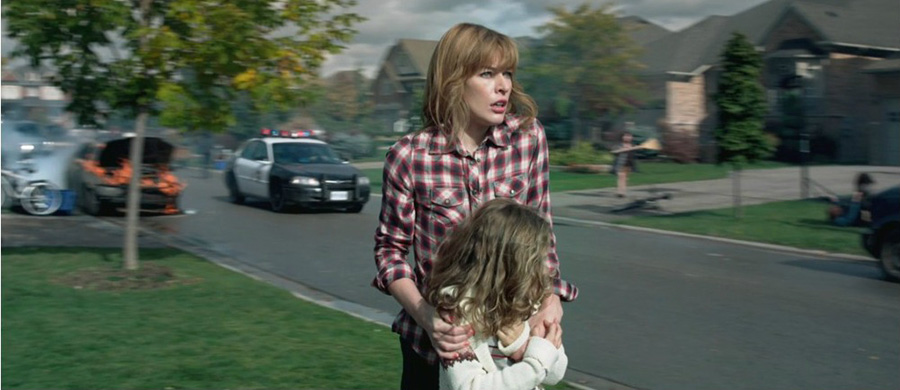
Meanwhile: Major Cain has been eyeballing Dr. Ashford’s machinations and is waiting for everyone by the helicopter, with his pal Nemesis. Being the evil soul that he is, Cain captures Ashford but holds off killing him until he pits Nemesis against Alice in what is sure to be the fight of the century. Alice recognizes her bud Matt from the previous film and refuses to kill him, even though she has the upper hand. Superpowers you know. Nemesis, appreciating the courtesy helps Alice wipe out the bad guys and dies in battle, leaving Alice and the others free to make it onto the helicopter and away. Cain is left behind as din-din for the ravening horde and a nuke is dropped upon all and sundry in an attempt to wipe out the T-Virus once and for all.
Finally: Alice once again escapes only to be nailed again when the helicopter gets caught in the blast zone and crashes into a mountain range, getting herself impaled on a metal pole. The ever present Umbrella scientists claim her, whisk her off to Chicago and set about healing her. She comes to herself in a water tank, completely healed and being studied by Dr. Isaacs. Isaacs and his team get her dried off and settled in and begin to interrogate her. Initially it would seem she is again suffering from amnesia, but suddenly informs them, “My name is Alice and I remember everything.” Upon stating this fact, she removes herself from their company—not easily but ultimately successfully—and steps onto the streets of Chi Town where she is immediately surrounded by armed guards. An Umbrella SUV pulls up at this opportune moment and drags her into the back seat where she finds that the occupants of the vehicle are none other than Jill, L.J., Angela and our old friend Carlos. Angela asks Alice if she’s all right and Program Alice is activated.
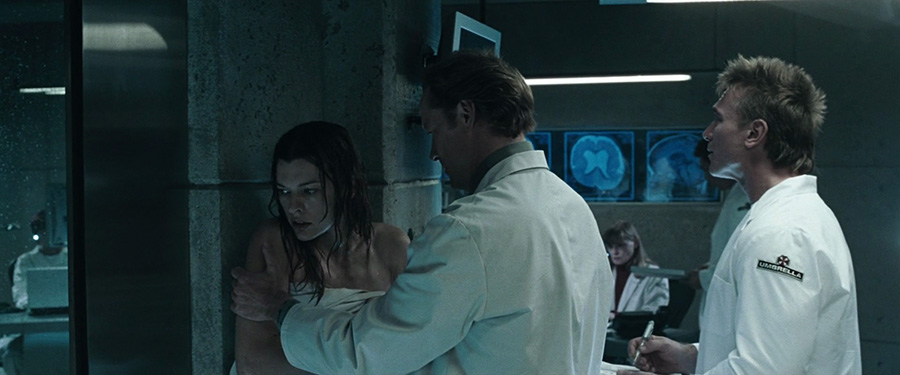
RESIDENT EVIL: EXTINCTION opens to the astonishing news that nuking Raccoon City did not eradicate the T-Virus. Umbrella wasn’t able to do anything to stop it and within months, the entire world was affected. Five years after and the globe is lousy with zombies. Umbrella has gone underground, literally, into various Hives and is attempting to isolate a vaccine and a cure. Dr. Isaacs is convinced that because of Alice’s blood being able to bond with the T-Virus, he can synthesize a cure if only he can get her back into his lab so he has enough of her blood available to him. Umbrella Chairman Albert Wesker—totally unimpressed with Isaacs thus far—refuses to go hunting for her until they know for sure that it will work. They tell Isaacs to clone our Alice and use the blood from the clones to experiment with and call them in the morning.
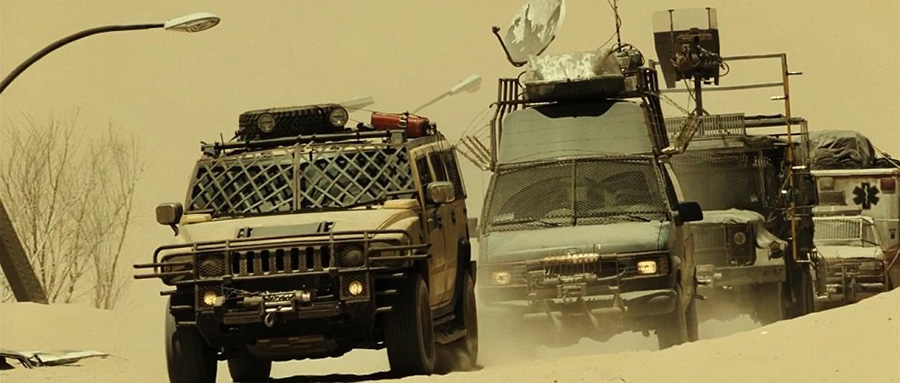
On the Road Again: Carlos and L.J. have gotten chummy with Claire Redfield, the leader of a convoy of uninfected nomads that include, among others, K-Mart, Mike, Chase and my personal favorite, Nurse Betty. This lot are roaming the desert countryside looking for motels and gas stations where they might locate supplies with which to continue surviving. During a foray into an abandoned motel, L.J. gets nailed by a lurking zombie. The next day a murder of infected crows descends upon the caravan, killing Nurse Betty and the operator of the rolling flamethrower they have in their midst. Of course this causes the flamethrower itself to run amok, with no one to guide it, threatening the lives of both Carlos and an unknown member of the luckless band. Enter Super Duper Alice, who having been in the clutches of Dr. Isaacs in Chicago, has developed even more superhero powers, in this case, the psionic ability to redirect the fire and roast the crows.
Alice and Claire are introduced and immediately discuss the diary Claire stumbled across in the desert that speaks of a Shangri La like location in Alaska that has no infection. A bit of back and forth results in the entire crowd agreeing to head North to Alaska—via Las Vegas for supplies—and for fun, L.J. puts the bite on Carlos along the way. As one might imagine, this doesn’t go over well and the convoy engages in its own version of Desert Storm, resulting in the deaths of just about everybody including Mikey and Chase.
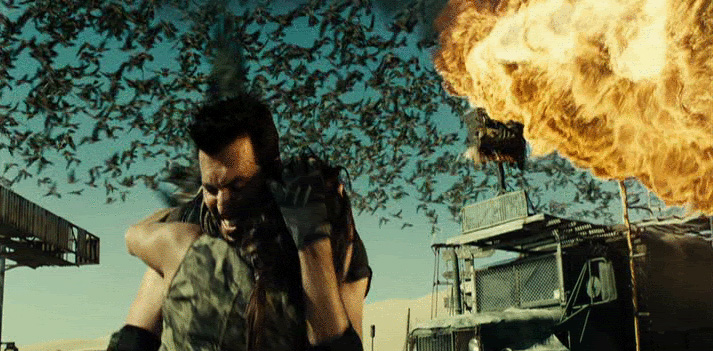
Meanwhile: Isaacs, having tracked Alice via psionic GPS, sends his Crimson Heads (super zombies developed sometime during the crow roast) to bushwhack the convoy in Vegas. Noting that there a ruckus on the road, Umbrella makes an abortive attempt to shut Program Alice down, but as she is now also Super Duper Alice, she blows their program and stays in the thick of the battle. When the dust settles, she and K-Mart locate Umbrella’s satellite office—a tent in the desert—and go after Isaacs. He attempts to flee and gets jumped by one of his own bad guys and (you guessed it) becomes infected. Alice and K-Mart have managed to get inside the tent and learn the location of the underground lab.
It Stays in Vegas: Carlos’ infection is killing him so he decides the best way through the zombie crush is to plow through and blow the whole thing to blazes. This sacrifice makes it possible for Claire and the remaining nomads to board a handy Umbrella-copter and head to Alaska. Alice stays behind to see what she can do about blowing the Hive.
Back at the Hive: Isaacs, infected with the T-Virus, has been slated for liquidation. In his lab, he injects himself with his handy-dandy antidote but he uses too much, goes nuts and kills everyone in the joint. The White Queen (sister of the Red Queen) locks him in his lab leaving the way clear for Alice to proceed through the facility, unmolested. She meets up with the White Queen and agrees to handle the Isaacs problem. On her way to locate him she stumbles across a clone of herself who wakes from a vegetative state and seemingly dies from shock. Isaacs and Alice meet up for a little one-on-one in a replica of The Mansion and just when things look bleak for our girl, the laser grid comes to life courtesy of Alice’s clone, and cuts Isaacs to pieces.
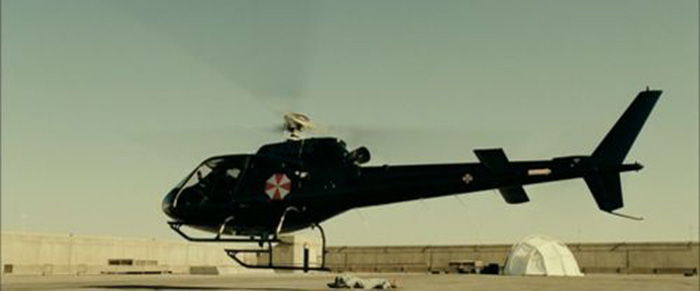
The End? Wesker has made himself scarce around the Vegas location and high-tailed it to Japan, where he informs all and sundry that the North American location is a goner. Through the magic of high tech facilities that still work even though 95% of the planet’s life forms are mindless flesh eaters, Alice appears at the board meeting with her clone beside her and rows upon rows of pods in the background—pods that are slowing giving birth to more and more Alice clones. She informs Japan that they are on their way and one assumes it’s not for a tea party. As Alice eyes her pods, the credits roll.
What I particularly like about these films is that they are self contained stories. There are plenty of openable doors if you wish to take the story to the next step, or it can be left alone. In this age of sequel upon sequel upon sequel, I find that to be most refreshing.
What I don’t like is the terse and staccato delivery of the lines and the fact that there is no actual conversation going on in the film. Much like the game it is based on, the movie presents no real humanity in the characters. Kudos then, to the actors who took this limited dialogue and managed to get this jaded old viewer to actually care about them; particularly Ms. Jovovich, whose ice-queen character could easily be dismissed as an anti-hero. Alice ultimately comes across as a shell-shocked victim of circumstance who is doing the best she can with limited resources. At this point, being aware that Resident Evil is her brother’s favorite game, I can’t help but wonder if he had a little something to do with her character’s development. With the advent of EXTINCTION, the character of Claire (Ali Larter) adds a new and sorely needed dimension to the series. The Alice character has begun to wear a bit thin as the only strong female character, and the thoroughly human Claire balances the act perfectly by lending new life and excitement to the mix. The Claire character pretty much saved this third in the series from being more of the same, something it looked to be in danger of becoming in the opening scenes.
Several hours later, having gotten thoroughly involved with all 3 films in the series, I found myself looking forward to the fourth installment, AFTERLIFE. I started digging around online to find out what I could.
The first thing I discovered was that Anderson and said he wouldn’t be making another RE film after the third installment. The second thing I learned was that he had filmed a fourth installment. I found out it was being filmed in 3D. I learned that Anderson had been privy to Cameron’s new process early on and was actually filming the thing with the same technique, rather than tossing 3D in as an afterthought to ride along on the success of AVATAR, as some have done recently. And I learned that the stunning Milla Jovovich is Paul W.S. Anderson’s wife and that RESIDENT EVIL is her brother’s favorite video game. Obviously Anderson felt there was life in the old girl yet—I refer to the film series, not Ms. Jovovich—and with the addition of 3D, a fourth film would, after all, be a reasonable and marketable venture.
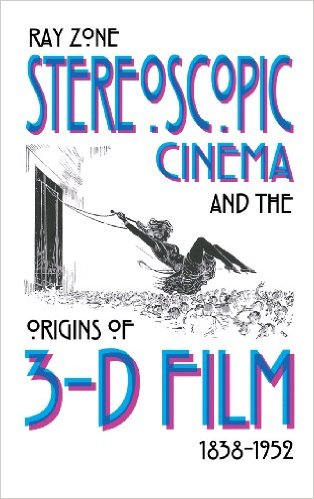 Being thoroughly unschooled in 3D (I know how to put on the glasses but that’s all), and being the only person on the planet that has not yet seen AVATAR, I was not thrilled with the prospect of RESIDENT EVIL going the way of William Castle. Anderson himself was coming back to direct this film, having been otherwise engaged when the second and third installments were being made, I was truly unhappy thinking he was about to turn his neat little series into a difficult to watch gimmick flick. As a result, I determined to find someone who knew his onions where 3D was concerned and find out what I could to put my mind at rest.
Being thoroughly unschooled in 3D (I know how to put on the glasses but that’s all), and being the only person on the planet that has not yet seen AVATAR, I was not thrilled with the prospect of RESIDENT EVIL going the way of William Castle. Anderson himself was coming back to direct this film, having been otherwise engaged when the second and third installments were being made, I was truly unhappy thinking he was about to turn his neat little series into a difficult to watch gimmick flick. As a result, I determined to find someone who knew his onions where 3D was concerned and find out what I could to put my mind at rest.
I banged around for awhile trying to locate this mythical sage when I stumbled upon Kristyn Humphreys who put me in touch with Ray Zone who literally wrote the book (STEREOSCOPIC CINEMA AND THE ORIGINS OF 3D FILMS 1838-1952 from University Press of Kentucky) on 3D. My thanks to all involved for the connection. Without it, this would be a pretty boring article.
Ray, wonderfully generous with his time, gave me a crash course in stereoscopic cinema from the early days to the present and I am now dying to see AVATAR, RESIDENT EVIL: AFTERLIFE, DARK COUNTRY and anything else they may throw at me.
My first question to Ray was how does the 3D of the William Castle films of the 50s differ from what James Cameron did with AVATAR? In order to answer the question properly, he first schooled me on William Castle’s work.
“When you say William Castle, I need to clarify something. He made a film called DRUMS OF TAHITI with Dennis O’Keefe in 3D. I think there were a couple of others that he actually made in the dual-band twin strip 3D process, so he actually is a 3D filmmaker. And of course, his wonderful gimmick films had a variety of promotional gimmicks.
“You may be thinking that 13 GHOSTS was a 3D film. It was not. It used a process called Illusion-O, which did use red and blue filters in the ghost viewer—I own one and am a fan of that film—but, the red and blue filters were used to give the viewer an option to either see the ghosts or to not see them. This was not a 3D film because you never were supposed to use the red and blue filters simultaneously. He used the red and blue filters in a way that created a special interactive way of looking at the film. He was one of the great gimmick filmmakers of all time.
Now that he had that cleared up, Ray moved on to the meat of the discussion.
“3D films have been made for over a century, prior to the release of the 1950s 3D films, particularly BWANA DEVIL which launched the boom. So from the very beginning of the invention of cinema and photography, the inventors were trying to create moving 3D images that had color and sound.
“Today, with the digital imaging and complex tool sets which are easier to use than ever, it’s not just big studios can make 3D movies. People are making their own 3D movies on their desktops at home with their computers and digital cameras. 3D movies are now possible in a way that they never have been before.
“All 3D is fundamentally the same in principle. That means you have two movies; a left-eye movie and a right-eye movie that you have to watch to see 3D. The left-eye movie is taken from the left-eye point of view, and the right-eye, the right. In the 50s the movies in 3D were projected with two projectors, showing the left-eye filmstrip and the right-eye filmstrip with two projectors that were interlocked to stay in sync; and the movies were shot with two cameras that were interlocked.
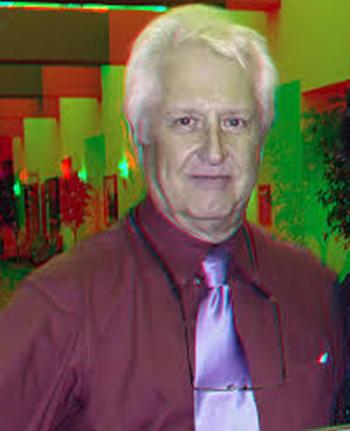 Ray Zone (1947-2012)
Ray Zone (1947-2012)
“A misconception about the 50s 3D films is that they were shown in red/blue or red/green anaglyphic 3D. In fact, they were not. They were all shown in polarizing dual strip projection on a silver screen. There were a couple of anaglyph films, but for some weird reason, there is this wide-spread—false—cultural memory that the 50s films were shown in anaglyph.”
I recalled viewing CREATURE FROM THE BLACK LAGOON at a theatre out in the wilds of New Jersey sometime in the 80s or 90s and, based on my short lesson thus far, I know it was anaglyph. So how could that be, if this master said it wasn’t?
“In the 70s, Universal did make anaglyphic red/blue prints of both CREATURE FROM THE BLACK LAGOON and IT CAME FORM OUTER SPACE—so that it could be shown with a conventional movie projector, single strip, and on a regular white screen with the audience using red and blue glasses to see it in 3D. So that may be why people think the 50s 3D films were seen in anaglyph.
“Monster films in 3D are a natural; they’re a subject that is really great for 3D movies, because with 3D movies, you can make images come out into the audience’s face, which creates a real thrill. It’s a spectacle. Dual-band films in the 50s, like IT CAME FROM OUTER SPACE and THE CREATURE FORM THE BLACK LAGOON, both directed by Jack Arnold at Universal, are real 3D classics that use this capability.”
So, I wondered, when did 3D come back? I discovered, to my astonishment, that it had never really gone away. It’s been hiding out in the back alleys of monsterdom, just waiting for its chance—having morphed, Cthulhu-like—to spring out onto an unsuspecting public and take over the film industry once and for all.
“In the 80s, we had 3D movies that used single strip 35 mm 3D technology; these movies took the left and right eye images of the action and stacked them on top of each other. With a mirror device in front of the projector, the single strip 3D was split out so that the left eye was delivered on screen through one polarizer, and the right through another. Linear polarizing filters are what make 3D work in the cinema; with the use of a silver screen, it does what is called conserving the polarization which is transmitting the light at a specific angle so that the left eye sees the left eye movie and the right eye, the right.
“There were some interesting single strip 3D monster films like PARASITE, which was in the single strip stereovision format, directed by Charlie Band, and it’s actually a very good film with some really scary off the screen moments with the monster. It also has the distinction of being Demi Moore’s first film.
“And of course JAWS 3D continued the franchise and was one of the top grossing 3D films. Perhaps the best made 3D film from that decade though, was FRIDAY THE 13TH PART III. It opened August 13, 1982 and it did great box office. It was the first day and date 3D release that opened in over a thousand theatres at the same time. That kind of widespread day and date release with a 3D film had never happened before.”
The 80s blew by me so fast. For me it was a lost decade where film going was concerned so this was truly all news to me. I resurfaced in the 90s but the work I was doing then concerned classic horror and mystery so I never saw what came next.
“Late in the decade and into the 90s the IMAX 3D process arrived and that kept 3D movies alive. The IMAX format uses what’s called 15/70. It’s 70 mm film that travels horizontally through the projector so that each frame of film is 15 perforations wide. That frame size is nearly 10 times the size of a conventional 35 mm frame, and of course they are projected—two of them, dual bands—upon a giant silver screen, eight stories high. Numerous 3D films came out in the IMAX format, starting in the late 80s; in the 90s they really tooled up and started rolling out into multiplex cinemas in 1997. IMAX 3D films are still being shown today—some of them are conversions from 2D material, like SUPERMAN RETURNS with a 3D conversion segment as well as HARRY POTTER in two different 3D conversion movies.
“In 2004, POLAR EXPRESS came out in IMAX 3D. You could only see POLAR EXPRESS 3D in IMAX. You could go to a regular cinema and see it in 2D, and that marked the beginning of a trend which continues today. When a film is released in 3D and 2D, the 3D version of the film makes three times the box office of the 2D version. That’s the huge factor driving 3D cinema today.
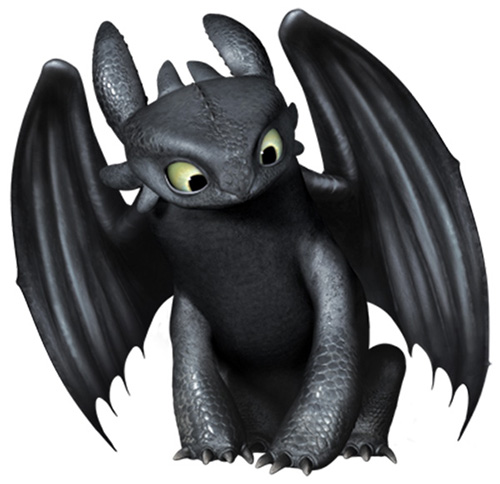 Your editor is delighted to have an excuse to run a shot of
Your editor is delighted to have an excuse to run a shot of
her favorite dragon, the ever popular Toothless!
“When digital 3D cinema began in 2005 that held true: CHICKEN LITTLE in 3D and it was released simultaneously on film in 2D, to a couple of thousand theatres—and digitally in 3D to about 85 digital 3D cinemas. A significant portion of the box office for CHICKEN LITTLE was earned by a very small number of 3D theatres.
“Since then, we’ve had some wonderful digital 3D films, like MONSTER HOUSE, MEET THE ROBINSONS and this last year we saw UP and other wonderful releases like G-FORCE and CLOUDY WITH A CHANCE OF MEATBALLS. These are all CG (computer generated) animated 3D films.
And so we arrive at last at James Cameron’s blockbuster.
“With the release on December 18, 2009 of AVATAR, 3D movies truly came of age. AVATAR is the longest 3D movie ever made, with a running time of 2 hours and 40 minutes. It was released on IMAX 3D, digital 3D cinemas and any number of digital 3D formats that we now have. We have several processes for 3D digital movies and AVATAR was released in them all. In a very short period of time, AVATAR not only gained really good, solid critical notices from the major film critics, but it became the top box office film of all time, earning something like 2.7 billion dollars ( as of this writing, May 2010), and moving ahead of TITANIC which was formerly number one in the box office. (As of 12/31/16 the number stands at $760,507,625 and has been topped by STAR WARS: THE FORCE AWAKENS at $936,662,225. TITANIC is now #3. It should be noted that STAR WARS reached that number in a year, whereas AVATAR has taken 7 years to reach that number. Something old beats something new—again. Or does it?)
“The most spectacular thing that James Cameron did with AVATAR, was to make a 3D film that was not gimmicky; it was used for stereoscopic storytelling in a way that was emotionally moving. He truly achieved an integrated work of cinematic art buy using 3D in the same way that sound and color and widescreen had been used previously for cinematic storytelling. Cameron’s technology was enormously sophisticated and he invented new camera technology to integrate the live action capture—the performance capture—with the computer generated 3D background.
“Now, we will continue to see both CG animations, like HOW TO TRAIN YOUR DRAGON—which is a wonderful film—and SHRECK and TOY STORY 3. At the same time we will see horror films like FINAL DESTINATION 4—which came out last year and took number one at the box office on its opening weekend—or MY BLOODY VALENTINE.
“So, we have horror films and CG animations coming out simultaneously and the horror films exploit—once again—the off the screen, into the audience visual effect which is perfect for the horror film. But other CG animated films, like UP—which as a first in film history was a 3D film nominated for Best Picture by the Academy—along with AVATAR. Two 3D films in one year, for the first time in history, nominated for the Best Picture award.
“So all of this means that 3D has come of age as a business, as a form of art and a regular ongoing part of cinema. We will see films that have been shot in 2D and converted to 3d, like CLASH OF THE TITANS and ALICE IN WONDERLAND, both of which used live action that was shot 2D and converted to 3D.
“It’s a hybrid of 3D conversion and computer generated backgrounds which were 3D as created in the computer. So now, the tool set for 3D movie makers includes shooting live action in 3D, creating CG 3D and stereo conversion of 2D material to 3D and we will see increasingly, the filmmakers who are making 3D movies, mix and match this variety of tools for this stereoscopic storytelling.
I have read reviews of both AVATAR and CLASH OF THE TITANS and I notice that people are not as happy with CLASH as they were with AVATAR—and it had nothing to do with the story, it had to do with the actual 3D effect. So what happened?
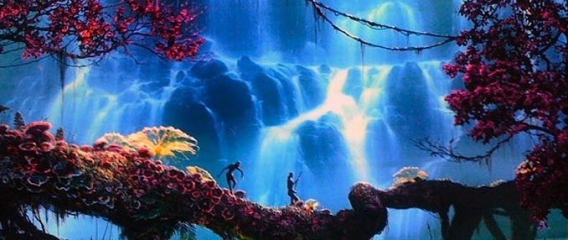 AVATAR's Pandora
“Conversion of flat movies is an art form. If you practice an art form and you have to create a finished work of art in a very short period of time, it’s not going to be as good as a work that has sufficient time to be converted to 3D. That was the case with CLASH OF THE TITANS. James Cameron took five years to make AVATAR and late in the day, executives at Warner Brothers—eight weeks before release—decided to convert CLASH to 3D to cash in on the box office. As a result, the 3D has a lot of mistakes in it. It’s not as easy to look at nor is it as pleasant as other films where more care has been lavished upon the 3D effects. That’s why the 3D is not that good in CLASH—because they hired armies of people to convert it to 3D and did not give them enough time to do it properly. It was a solid executive decision if the money is the only question.
Having set my mind to rest regarding RESIDENT EVIL: AFTERLIFE, and setting my tooth for September when the film is slated to open, I wanted to be sure to give Ray the opportunity to crow a bit about his own 3D project: Thomas Jane’s DARK COUNTRY.
“DARK COUNTRY is an innovation in filmmaking technology. It is the first 3D film to use silicon imaging heads for stereoscopic capture of the live-action photography.”
This was something we hadn’t yet discussed and I wanted to know what he meant.
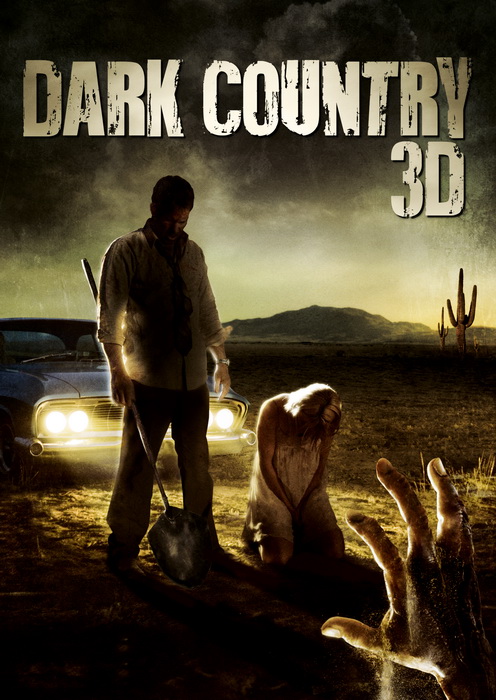
“It means it was captured digitally in 3D, and at the time it was shot, in late 2007, nobody had used this technology. It was brand new. It was what the 3D technician on the shoot, Max Penner, called a “science project”. Max is the man at Paradise FX who assembled the rig to shoot DARK COUNTRY in 3D.”
And in brief, what is DARK COUNTRY about?
“The story is Edgar Ulmer’s DETOUR in The Twilight Zone. It is an intimate drama in the way that DETOUR is, with two people in a car, going into the nightmare of the dark country. It’s set entirely in the nighttime, in the desert.
“The making of the film was all about using the 3D, not as a gimmick, but as a way to make the story have more dramatic impact. To plan for the 3D shooting of it, Tom Jane and I, prior to going on location, sat down with a fully storyboarded version of the movie and we created a color depth graph, using color so that we planned the 3D in each shot. These were the 3D Bible, and they were distributed to the cameraman Geoff Boyle, the camera operator Howard Smith and to Max Penner, so that everybody would be on the same page with the 3D shooting of THE DARK COUNTRY. Eventually it was completed and edited and over 90 green screen 3D shots assembled. It had its public 3D premier at the Long Beach Comic Con last October (2009), and was very well received by an audience of over 400 people.”
So, congratulations all around to Ray and Thomas Jane, James Cameron and his extraordinary innovations and to the fans of the fantastic; as Ray says, 3D is here to stay and that can only bode well for the unexpected fourth chapter in the RESIDENT EVIL series and film goers worldwide. To the future!
{RESIDENT EVIL: THE FINAL CHAPTER is set to hit theatres in January 2017.]
|







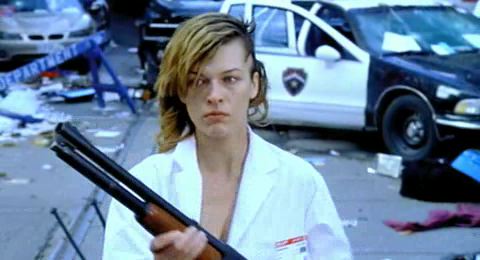





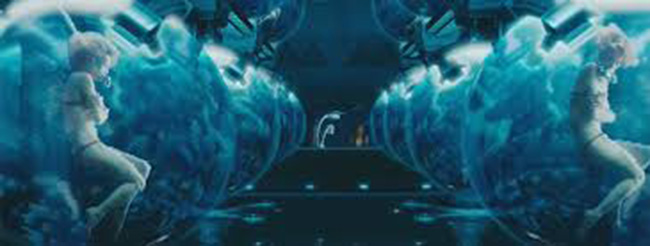
 Being thoroughly unschooled in 3D (I know how to put on the glasses but that’s all), and being the only person on the planet that has not yet seen AVATAR, I was not thrilled with the prospect of RESIDENT EVIL going the way of William Castle. Anderson himself was coming back to direct this film, having been otherwise engaged when the second and third installments were being made, I was truly unhappy thinking he was about to turn his neat little series into a difficult to watch gimmick flick. As a result, I determined to find someone who knew his onions where 3D was concerned and find out what I could to put my mind at rest.
Being thoroughly unschooled in 3D (I know how to put on the glasses but that’s all), and being the only person on the planet that has not yet seen AVATAR, I was not thrilled with the prospect of RESIDENT EVIL going the way of William Castle. Anderson himself was coming back to direct this film, having been otherwise engaged when the second and third installments were being made, I was truly unhappy thinking he was about to turn his neat little series into a difficult to watch gimmick flick. As a result, I determined to find someone who knew his onions where 3D was concerned and find out what I could to put my mind at rest.


